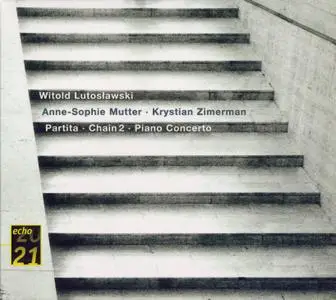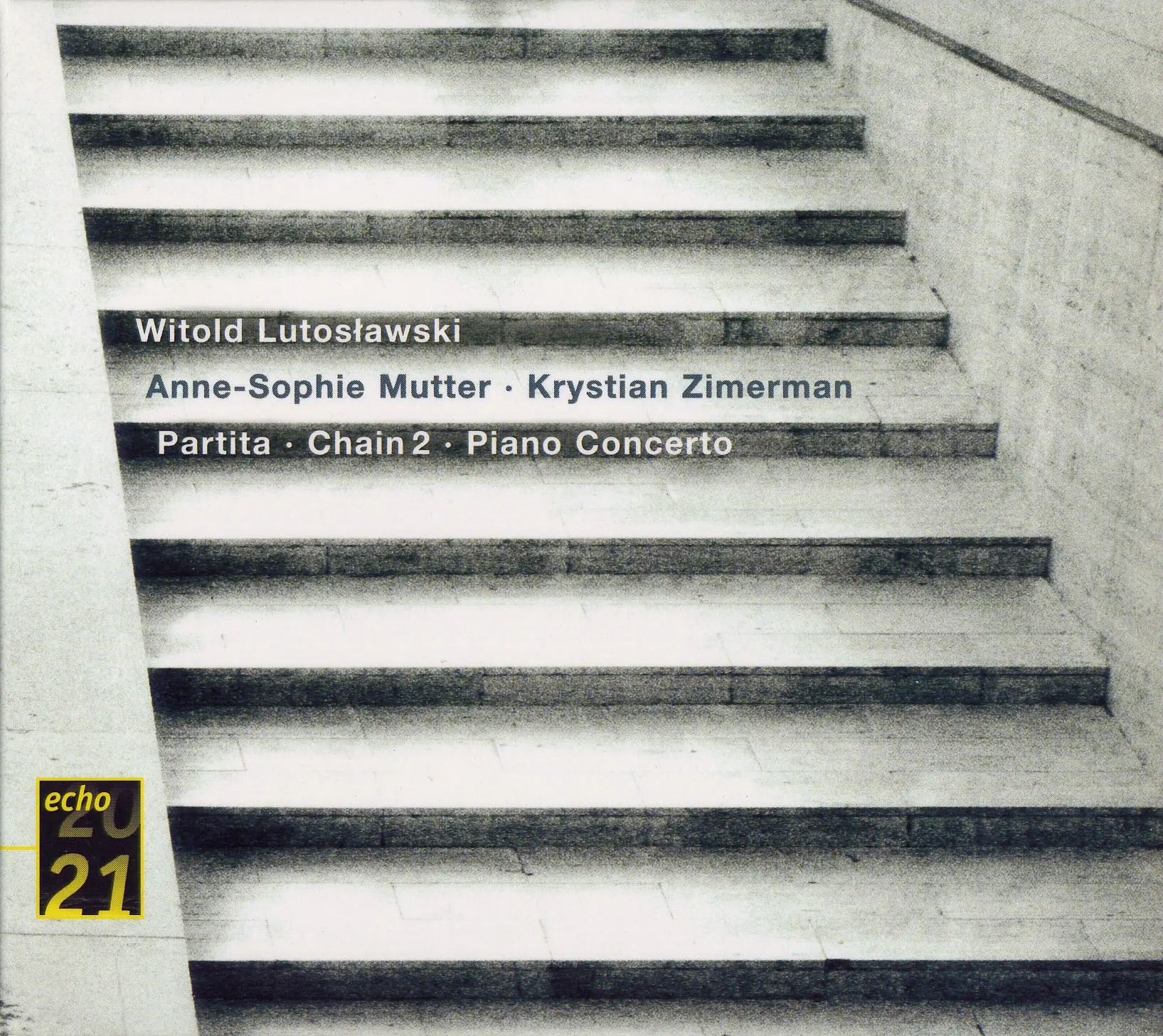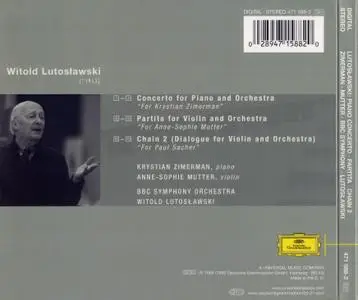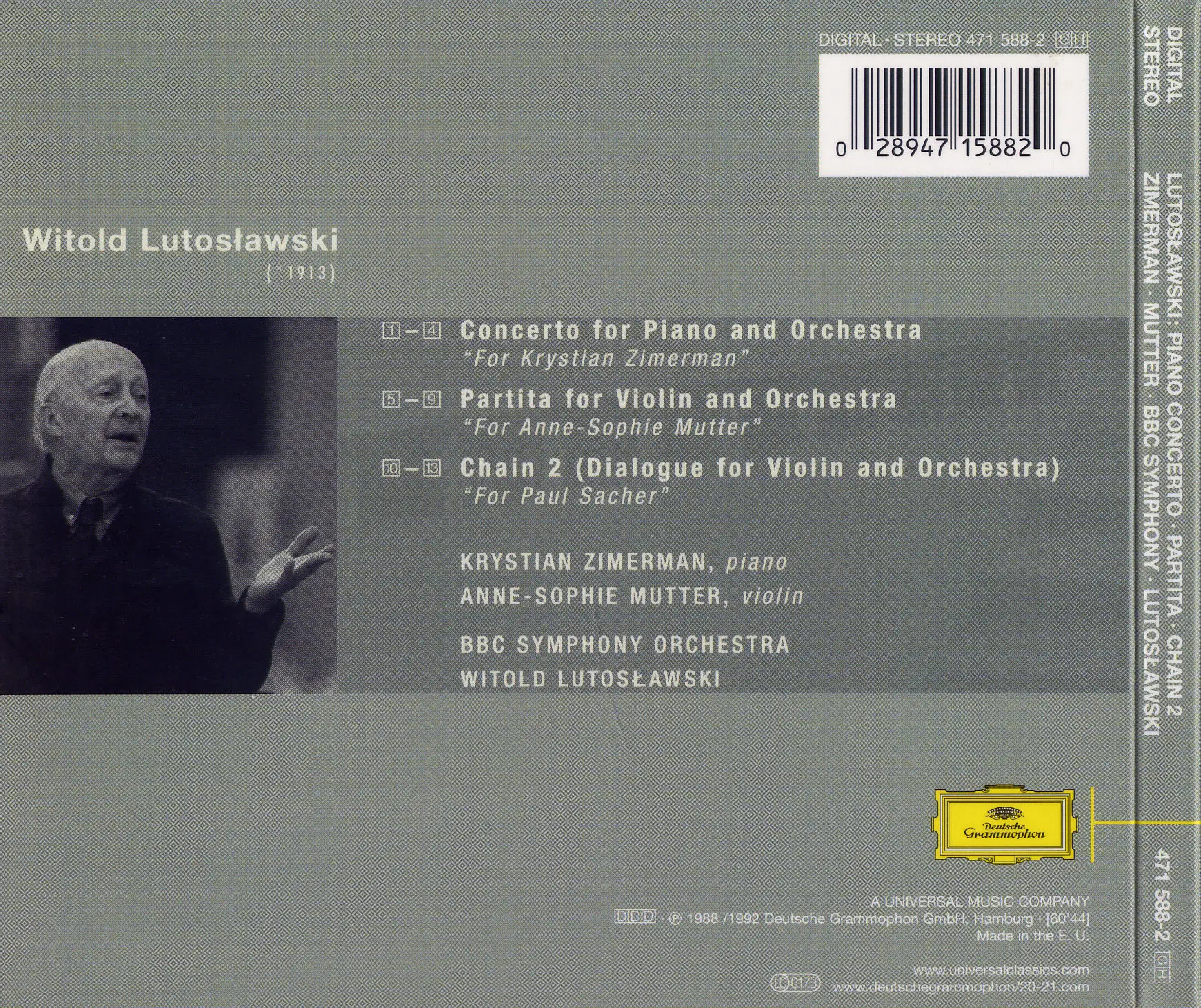Anne-Sophie Mutter, Krystian Zimerman - Witold Lutosławski: Partita, Chain 2, Piano concerto (1992)
EAC | FLAC (image+.cue, log) | Covers Included | 60:44 | 265 MB
Genre: Classical | Label: Deutsche Grammophon | Catalog: 471 588-2
EAC | FLAC (image+.cue, log) | Covers Included | 60:44 | 265 MB
Genre: Classical | Label: Deutsche Grammophon | Catalog: 471 588-2
Bartók's influence in the Forties and Fifties grew to a great height throughout the Soviet satellites of Eastern Europe, particularly among the better composers. True, one found serialists like Eisler in East Germany and Tadeusz Baird in Poland, but they seemed exceptions, rather than the rule. In Poland, for example, we meet the examples of the remarkable Grazyna Bacewicz and Witold Lutoslawski. Lutoslawski especially seemed to regard Bartók as Brahms did Beethoven, a spiritual father who inspired within him both an almost stifling reverence and the need to break free. Although we tend to think of Lutoslawski as a monument among post-war composers, he did change. The early stuff owes just about everything to Bartók. To say this doesn't trivialize Lutoslawski. It takes a great composer to "do" Bartók so well. A middle period follows, during which Lutoslawski reacts against the older man. The music is almost feverishly experimental. The work in the style we think of as Lutoslawskian accepts Bartók's influence, if it ever comes up, but that's not its point. As Brahms remarked to someone who pointed out a Beethoven reference in Brahms's first symphony, "Any fool can see that."
All the works on the CD appear relatively late in Lutoslawski's career. This CD repackages previous tracks. The Partita joins Chain 2 and the Stravinsky violin concerto on DG 423696-2, while the piano concerto brings with it Chain 3 and the Novelette on DG 431664-2. If you have those, don't bother with this one.
Other than that, the performances are stunning. The BBC plays to a fare-thee-well, while Lutoslawski does a fine job on the podium. I won't say I can't imagine these works done better, but the readings will not likely be bettered for a while. The conductor certainly knows what the composer wants. Zimerman and Mutter, the original soloists and dedicatees, perform at the top of their considerable game, and, since Lutoslawski played both the piano and the violin himself, he understands how to make these instruments sound, even among unusual textures.
Lutoslawki's major instrument was the piano, and his catalogue is filled with terrifically effective, even virtuoso stuff, from at least the early (1943) Variations on a Theme of Paganini for two pianos on. The concerto, however, comes from 1987 (the composer died in 1994)—so, pretty late—although the composer had been thinking about the work for at least ten years previously. The liner notes by Anthony Burton make much of the technique of the piece, the compositional "gadgets," as it were. The two main ones are Lutoslawski's contrast of ad libitum (music without a strong metric pulse, like Hovhaness's "spirit murmur") and a battuta (music with a strict pulse, something the conductor can beat) and his notion of the "chain." The "chain" grows out of the composer's ad libitum music and apparently updates the baroque notion of stretto. That is, short strands or even sections of music, not necessarily related and not necessarily coordinated in strict time, overlap each other. We oohed and aahed over these things when they were new, but fortunately the music doesn't depend on their novelty, any more than the power of a Bach cantata depends on its having a fugue. I think by now listeners can "just listen," enter Lutoslawski's emotional world, without having to worry about the composer's technique.
We can, however, note the potential for the music, through these techniques, to degenerate into an undifferentiated aural ooze. Lutoslawski's great expressive and rhetorical command never allows this to happen. The piano concerto's opening movement glitters in a delicate way that will remind listeners of Bartók's sonata for two pianos and percussion (perhaps even parts of Strauss's Also sprach Zarathustra), minus actual quotes. Lutoslawski ensures that the tension between strict and free rhythm remains an element of drama, rather than of technique only. The first movement acts as a kind of wind-up, Vaughan Williams's "wisps of music floating about," trying to coalesce into something purposeful. The soloist provides the gravitational focus, accreting to itself more and more of the orchestra. The music sputters, pulls up its socks, rears back, and finally, after a sustained build-up, leaps directly into a wild toccata second movement. Rhythm is the musical point. For some reason, the entire concerto has a nocturnal "feel" to it. In the second movement, night terrors alternate with flocks of demons fading off into another part of the forest and the next movement. This one, roughly an A-B-A structure, sings like a voice in the night, sad and meditative on what has gone on before. Zimerman has always impressed me with his command of keyboard color and emotional range—not for nothing do people like his Chopin and Debussy—and Lutoslawski demands not only these, but a kind of emotional maturity, which Zimerman delivers. The third movement leads without a break to the fourth, a passacaglia—something I wouldn't have known, had not Burton pointed it out. Even so, I don't yet hear it, and, without a score, it will take me a while. Again, however, that doesn't keep me entirely out of the music, which rhetorically (as opposed to architecturally) seems a conflict between strict and free rhythm, fast and slow tempi, this time in the confines of a single movement, strict and fast win out, in a blazing close that gives you as much bang for your buck as you would wish.
Lutoslawski first composed a violin-and-piano version of the Partita for Zukerman and composer-pianist Marc Neikrug in response to a commission from the St. Paul Chamber Orchestra. I'm no Zukerman fan and have difficulty imagining that he actually enjoyed playing it, given his usual know-nothing comments on modern and contemporary music. It doesn't surprise me that he didn't record it. However, Mutter so impressed Lutoslawski with her performance of Chain 2, he orchestrated the Partita especially for her. The work consists of five movements, two of which are ad libitum interludes after the first and third movements. The three "real" movements are based on Baroque dance forms: courante, air, and gigue. While hardly light music, it seems to me Lutoslawski in a relatively relaxed mode. It's a very attractive work. The orchestration is that of a master, rich and imaginative without necessarily calling attention to itself. The composer uses the piano as an orchestral sonority, particularly in the first and last movements, I suspect because he couldn't quite translate all of it into orchestra-ese. The beauties of this work, particularly those of a quiet section toward the end, can just about break your heart. Mutter has always been an elegant, patrician player (as well as a babe), and this music suits her down to the ground.
I realize that Chain 2 counts as a major work in Lutoslawski's catalogue, but I've never entirely warmed to it. I admire it, as I might admire blueprints or a well-reasoned legal brief. However, as I continue to listen, it sinks in a bit more—unlike many pieces that simply increase my antipathy and where familiarity breeds contempt. This time around, I found myself hooking into the fast parts of the piece. Again, the free-vs.-strict rhythmic dichotomy prevails. Lutoslawski calls it a "dialogue" rather than a concerto, and, indeed, its dedication to Paul Sacher also suggests large-scale chamber music. One can find that element in the work, but one can also single out plenty of passages where the soloist contends "heroically" with the orchestra or where the ensemble mainly supports the soloist, as in the typical concerto. My favorite movement, contrary to what I've said so far, has always been the slow third movement, passionate and demanding. Mutter meets the emotional requirements of the piece, without stepping into bathos. To me, this account also represents the best conducting and orchestral playing on the CD.
The sound is wonderful, capturing Lutoslawski's brilliant textures and precise balances, without crossing the line to the hokey.
Track List:
Concerto for Piano and Orchestra
1. I. 110 - attacca
2. II. presto - attacca
3. III. 85 - attacca
4. IV. 84
Partita for Violin and Orchestra
5. I. allegro giusto
6. II. ad libitum
7. III. largo
8. IV. ad libitum
9. V. presto
Chain 2: Dialogue for Violin and Orchestra
10. I. ad libitum
11. II. a battuta
12. III. ad libitum
13. IV. a battuta - ad libitum
Performers:
Krystian Zimerman, piano
Anne-Sophie Mutter, violin
BBC Symphony Orchestra
Conductor: Witold Lutosławski
Exact Audio Copy V0.99 prebeta 5 from 4. May 2009
EAC extraction logfile from 30. August 2010, 19:54
Witold Lutoslawski / Partita - Chain 2 - Piano Concerto
Used drive : ASUS DRW-1814BLT Adapter: 2 ID: 2
Read mode : Secure
Utilize accurate stream : Yes
Defeat audio cache : Yes
Make use of C2 pointers : No
Read offset correction : 6
Overread into Lead-In and Lead-Out : No
Fill up missing offset samples with silence : Yes
Delete leading and trailing silent blocks : No
Null samples used in CRC calculations : Yes
Used interface : Native Win32 interface for Win NT & 2000
Used output format : Internal WAV Routines
Sample format : 44.100 Hz; 16 Bit; Stereo
TOC of the extracted CD
Track | Start | Length | Start sector | End sector
––––––––––––––––––––––––––––-
1 | 0:00.00 | 5:38.15 | 0 | 25364
2 | 5:38.15 | 4:38.50 | 25365 | 46264
3 | 10:16.65 | 7:23.60 | 46265 | 79549
4 | 17:40.50 | 8:08.20 | 79550 | 116169
5 | 25:48.70 | 4:14.30 | 116170 | 135249
6 | 30:03.25 | 1:11.62 | 135250 | 140636
7 | 31:15.12 | 6:22.71 | 140637 | 169357
8 | 37:38.08 | 0:47.27 | 169358 | 172909
9 | 38:25.35 | 3:58.40 | 172910 | 190799
10 | 42:24.00 | 3:50.15 | 190800 | 208064
11 | 46:14.15 | 5:00.45 | 208065 | 230609
12 | 51:14.60 | 4:58.69 | 230610 | 253028
13 | 56:13.54 | 4:30.21 | 253029 | 273299
Range status and errors
Selected range
Filename K:\EAC\Witold Lutoslawski - Partita - Chain 2 - Piano Concerto.wav
Peak level 98.0 %
Range quality 100.0 %
Copy CRC 9873595A
Copy OK
No errors occurred
AccurateRip summary
Track 1 accurately ripped (confidence 2) [43AF5FB8]
Track 2 accurately ripped (confidence 2) [BF7844C5]
Track 3 accurately ripped (confidence 2) [E735CCD7]
Track 4 accurately ripped (confidence 2) [DA76DBCA]
Track 5 accurately ripped (confidence 2) [CA392C05]
Track 6 accurately ripped (confidence 2) [08D370B0]
Track 7 accurately ripped (confidence 2) [F517010D]
Track 8 accurately ripped (confidence 2) [B5254046]
Track 9 accurately ripped (confidence 2) [E7EFFE9E]
Track 10 accurately ripped (confidence 2) [A3755C86]
Track 11 accurately ripped (confidence 2) [1A1213BA]
Track 12 accurately ripped (confidence 2) [438F7198]
Track 13 accurately ripped (confidence 2) [017230A0]
All tracks accurately ripped
End of status report
EAC extraction logfile from 30. August 2010, 19:54
Witold Lutoslawski / Partita - Chain 2 - Piano Concerto
Used drive : ASUS DRW-1814BLT Adapter: 2 ID: 2
Read mode : Secure
Utilize accurate stream : Yes
Defeat audio cache : Yes
Make use of C2 pointers : No
Read offset correction : 6
Overread into Lead-In and Lead-Out : No
Fill up missing offset samples with silence : Yes
Delete leading and trailing silent blocks : No
Null samples used in CRC calculations : Yes
Used interface : Native Win32 interface for Win NT & 2000
Used output format : Internal WAV Routines
Sample format : 44.100 Hz; 16 Bit; Stereo
TOC of the extracted CD
Track | Start | Length | Start sector | End sector
––––––––––––––––––––––––––––-
1 | 0:00.00 | 5:38.15 | 0 | 25364
2 | 5:38.15 | 4:38.50 | 25365 | 46264
3 | 10:16.65 | 7:23.60 | 46265 | 79549
4 | 17:40.50 | 8:08.20 | 79550 | 116169
5 | 25:48.70 | 4:14.30 | 116170 | 135249
6 | 30:03.25 | 1:11.62 | 135250 | 140636
7 | 31:15.12 | 6:22.71 | 140637 | 169357
8 | 37:38.08 | 0:47.27 | 169358 | 172909
9 | 38:25.35 | 3:58.40 | 172910 | 190799
10 | 42:24.00 | 3:50.15 | 190800 | 208064
11 | 46:14.15 | 5:00.45 | 208065 | 230609
12 | 51:14.60 | 4:58.69 | 230610 | 253028
13 | 56:13.54 | 4:30.21 | 253029 | 273299
Range status and errors
Selected range
Filename K:\EAC\Witold Lutoslawski - Partita - Chain 2 - Piano Concerto.wav
Peak level 98.0 %
Range quality 100.0 %
Copy CRC 9873595A
Copy OK
No errors occurred
AccurateRip summary
Track 1 accurately ripped (confidence 2) [43AF5FB8]
Track 2 accurately ripped (confidence 2) [BF7844C5]
Track 3 accurately ripped (confidence 2) [E735CCD7]
Track 4 accurately ripped (confidence 2) [DA76DBCA]
Track 5 accurately ripped (confidence 2) [CA392C05]
Track 6 accurately ripped (confidence 2) [08D370B0]
Track 7 accurately ripped (confidence 2) [F517010D]
Track 8 accurately ripped (confidence 2) [B5254046]
Track 9 accurately ripped (confidence 2) [E7EFFE9E]
Track 10 accurately ripped (confidence 2) [A3755C86]
Track 11 accurately ripped (confidence 2) [1A1213BA]
Track 12 accurately ripped (confidence 2) [438F7198]
Track 13 accurately ripped (confidence 2) [017230A0]
All tracks accurately ripped
End of status report
Thanks to the Original ripper (Poincare)!
Download:
Download:





